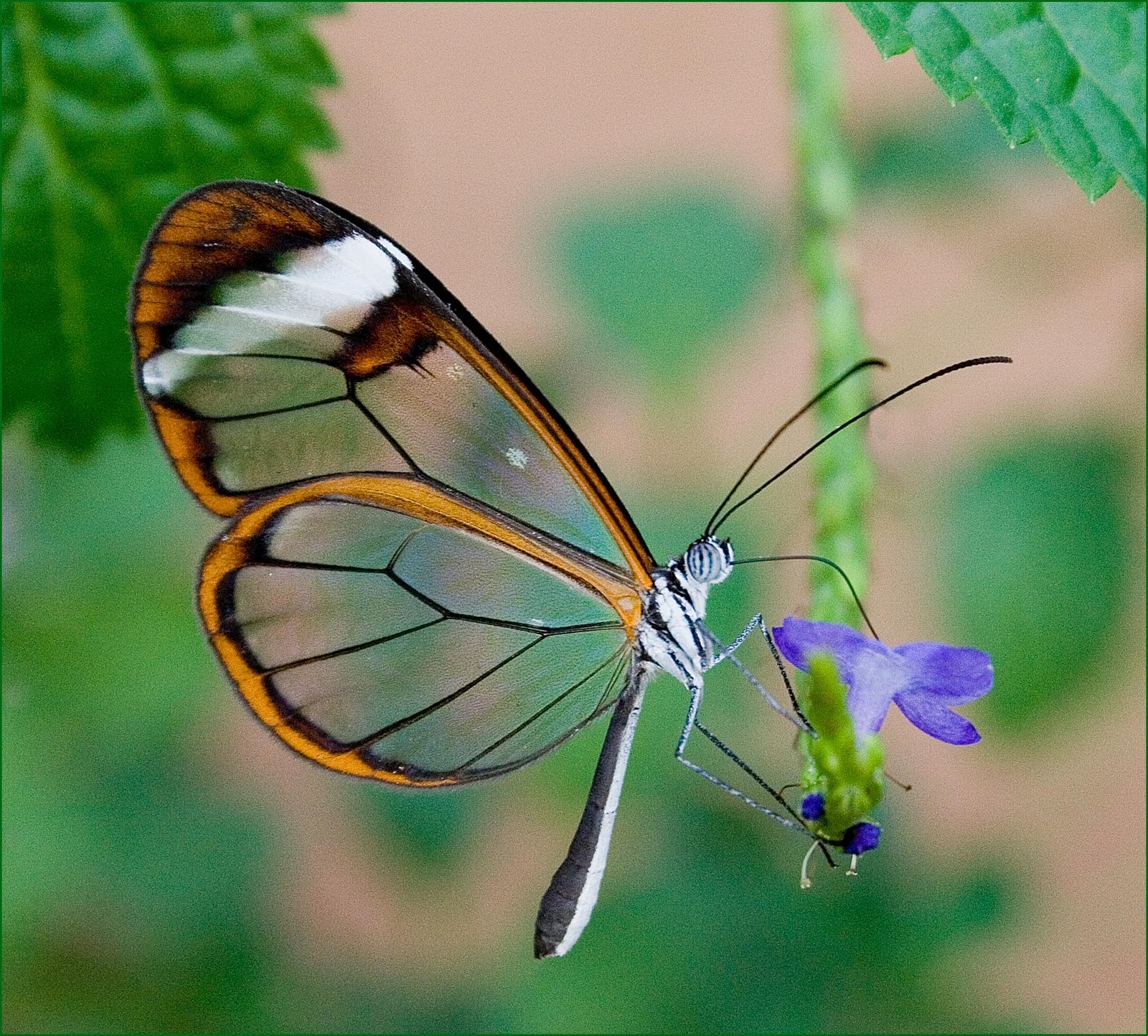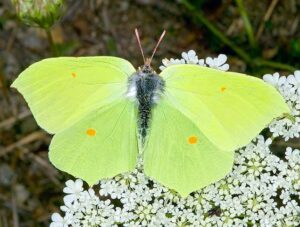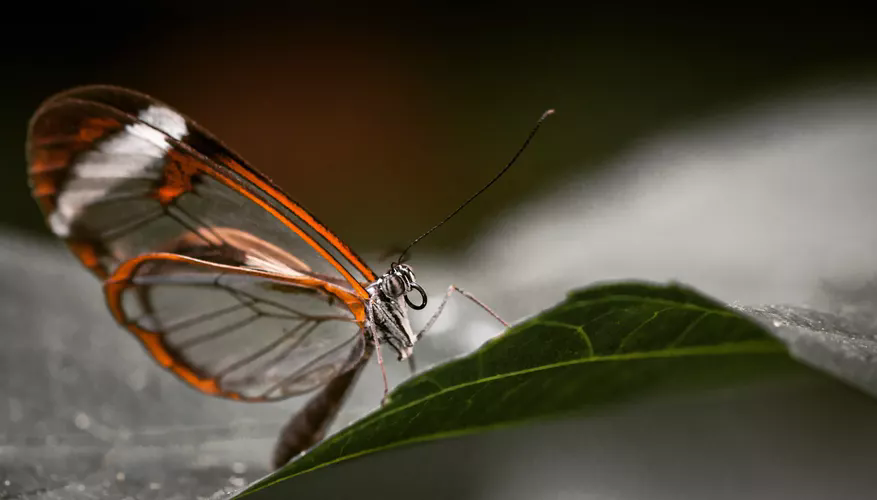
CENTRAL AND SOUTH AMERICA
Glasswing
Greta oto is a species of brush-footed butterfly and member of the subfamily Danainae tribe Ithomiini and sub-tribe Godyridina. It is known by the common name glasswing butterfly for its unique transparent wings that allow it to camouflage without extensive coloration. In Spanish speaking regions, it may also be referred to as espejitos, meaning “little mirrors” because of its transparent wings.
Did you know?
While its wings appear delicate, this butterfly is able to carry up to 40 times its own weight.
Greta oto is a species of brush-footed butterfly and member of the subfamily Danainae, tribe Ithomiini, and subtribe Godyridina. It is known by the common name glasswing butterfly for its transparent wings, which allow it to camouflage without extensive coloration. In Spanish-speaking regions, it may also be referred to as espejitos, meaning “little mirrors” because of its transparent wings.The butterfly is mainly found in Central and northern regions of South America, with sightings as far north as Texas and as far south as Chile. While its wings appear delicate, the butterfly is able to carry up to 40 times its own weight.In addition to its wing physiology, the butterfly is known for behaviors such as long migrations and lekking.Greta oto closely resembles Greta andromica.
Geographic range and habitat
The glasswing butterfly is most commonly found from Central to South America as far south as Chile, with appearances as north as Mexico and Texas.This butterfly thrives in the tropical conditions of the rainforests in the Central and South American countries.
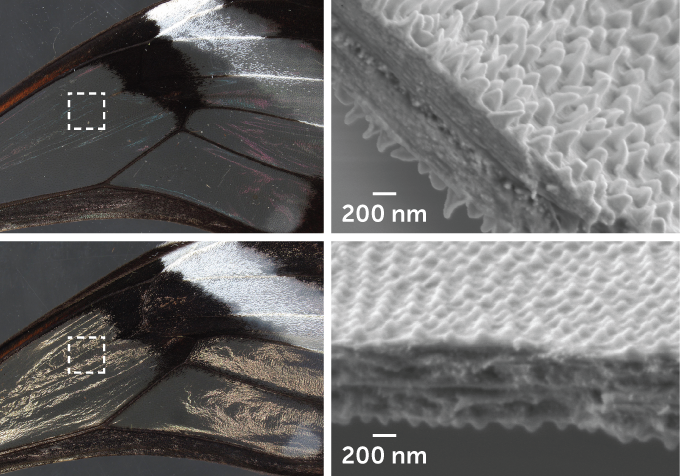
Life Cycle
- A Glass-wing Butterflies life cycle consists of egg, larvae, pupae, and adult.
Life Cycle of a Glass-wing Butterfly
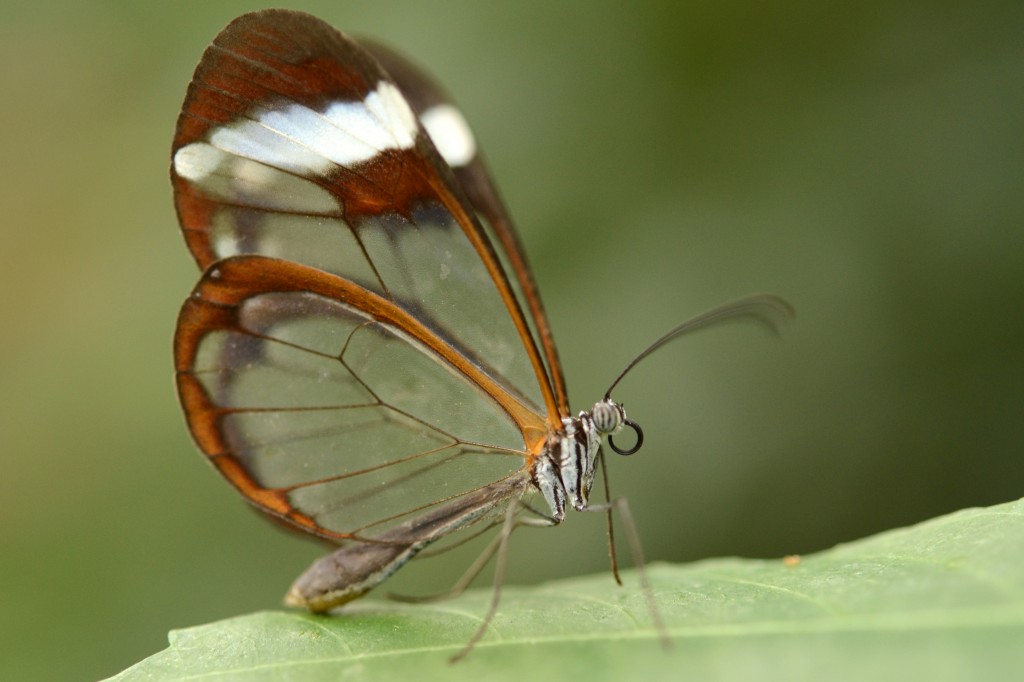
Aster Flowers
Aster flowers hold a special place in the lives of the glasswing butterfly, as their nectar is critical to its survival. Not only does the flower play a role in feeding, but also in mating, as certain chemicals created by the flowers are subsequently used during mate attraction.
Pink Glasswing Butterfly
One special species of glasswing butterfly out there has a special “blush” look to it. The pink glasswing butterfly – which can be found in the Amazon region – has clear wings at the top, which turn pinkish towards the bottom, making for a butterfly with matching blushing wings.
Facts About the Glasswing Butterfly
Most insects don’t bring to mind words synonymous with beautiful, but there is one exception to this rule – butterflies. These delicate creatures come in many shapes, forms and sizes; they occupy most regions of the earth, specifically warm and tropical regions. The types of butterflies are so diverse that one type – the glasswing butterfly – has clear, transparent wings.
Clear Wings
The most obvious fact relating to the glasswing butterfly is that it contains transparent wings, usually with an outline of black or orange — although the colors can vary. This unique characteristic occurs because the butterfly has no colored scales, which account for the color variations on most butterfly species. It has a wingspan of around 2 inches.
Strength
Most people know that many insects – such as ants – can lift many times their own body weight. If you ask most people about butterflies and strength, they’d probably never guess that, pound for pound, butterflies have ants beat by a mile. The glasswing is one especially strong species of butterfly. Although it might look weak, it has the ability to carry nearly 40 times its own weight. It is also very fast, with the ability to fly up to eight miles per hour for short periods of time.
Range and Type
The glasswing butterfly isn’t common all over the world. It is most well-known around Central America, extending up into portions of lower North America. The butterfly hails from the Lepidoptera order and Nymphalidae family.
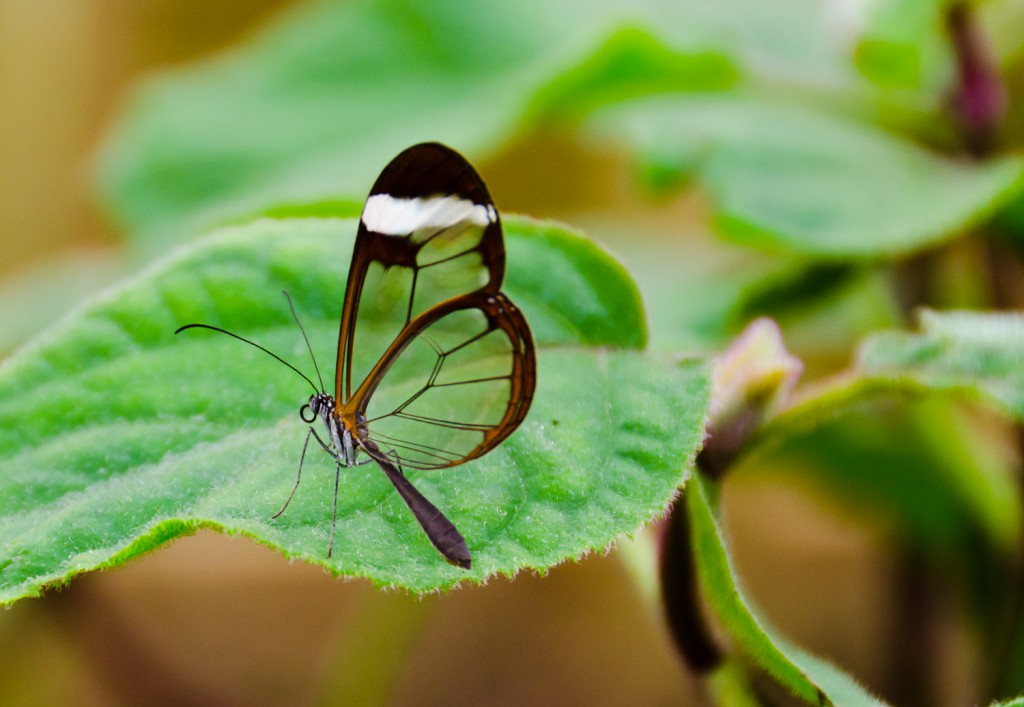
Adult
The adult glasswing butterfly can be identified by its transparent wings with opaque, dark brown borders tinted with red or orange. Their bodies are a dark brown color. The butterflies are 2.8 to 3.0 centimetres (1.1 to 1.2 in) long and have a wingspan of 5.6 to 6.1 centimetres (2.2 to 2.4 in).
Life cycle
Egg
Eggs are typically laid on plants of the genus Cestrum, a member of the nightshade family of plants, which serves as a food source for later life stages.
Larva
The caterpillars of the glasswing butterfly have green bodies with bright purple and red stripes. They are found on the host plants of genus Cestrum.[4] The larvae are cylindrical in shape with dorsal projections that are smooth with filaments. These properties make the larvae extremely reflective, which essentially causes them to be invisible to predators.
Pupa
The pupae are silver in colour. During the fifth instar stage, the pupa produces a silk pad on the lower surface of leaves through four spinning movements, onto which it attaches. The silk fibers are important in providing greater flexibility to the pupa attachment. The cremaster, a hooked bristle-like structure on the pupa, attaches to this silk pad by a series of lateral movements of the pupa’s posterior abdomen. Pupa attachment failure occurs when the silk pad breaks. Additionally, researchers have found the pupa attachment to have high tensile strength and toughness, which prevent the pupa from being pulled by predators or breaking off in the wind, allowing them to swing safely.
The Incredible Glasswing Butterfly
A butterfly with transparent wings? Surely not. Yet there is a species that exhibits this trait. Take a close look at the incredible Glasswing, an enchanting species that confounds science.
Greta oto may sound like the name of a silent movie star from Eastern Europe but is in fact the scientific name for one of the most exquisite – and little known – species of butterfly on the planet. This butterfly’s claim to fame is that its wings, spanning up to six centimeters, are almost completely transparent. That’s right, you can see just about right through them.
The common English name for this remarkable butterfly is glasswing, which in itself speaks volumes about the appearance of this small but unusual insect. However, it takes the romance languages to step in and give the butterfly the name which, for many, suits it best. The Spanish name for the glasswing is ‘espejitos’. Literally translated, this means little mirrors. Just a glance at the insect in question and one can imagine the thrill of pleasure when the moment of inspiration that came to its Hispanic name giver.
A close look at Greta oto reveals that between the veins of its wings the tissue is virtually see through) or, properly, translucent). Most other butterflies have colored scales which pattern the wings, quite often to ward off predators. The glasswing has another way of doing this entirely, but over the millennia it has evolved these specific wings to hide itself from predators rather than to warn them off. The only way that you can tell that it has wings at all are the borders, which are of a dark hue, sometimes bordering on the orange. Were it not for these borders, the glasswing would be more or less invisible to the human eye.
The glasswing is part of a specific clade of butterfly. Now for the science, as Jennifer Aniston used to say. A clade is a ‘branch’ and is a term used in the taxonomy of species. When groups of species has a single common ancestor (which does not necessarily need to be extant) then it is known as monophyletic. The common ancestor of the glasswing is long extinct but the clade it belongs to is known as the clearwing clade.
Transparency in nature is not something that has been very well understood. In order to achieve transparency the tissue must not absorb light. Neither can it scatter light, as this is the major obstacle to being see-through. Humans, for example, will never be able to be transparent because they have chemical and biological compounds that all have different refraction.
The wings of the glasswing must, therefore, have the same refractive index all the way through them as otherwise this transparency could not possibly occur. It is thought (a postulation at the moment rather than sure fire fact) that the surface of the wing has a covering of protrusions that are so small they can be called submicroscopic. They have a single refractive index and so do not scatter light, so making the wings transparent.
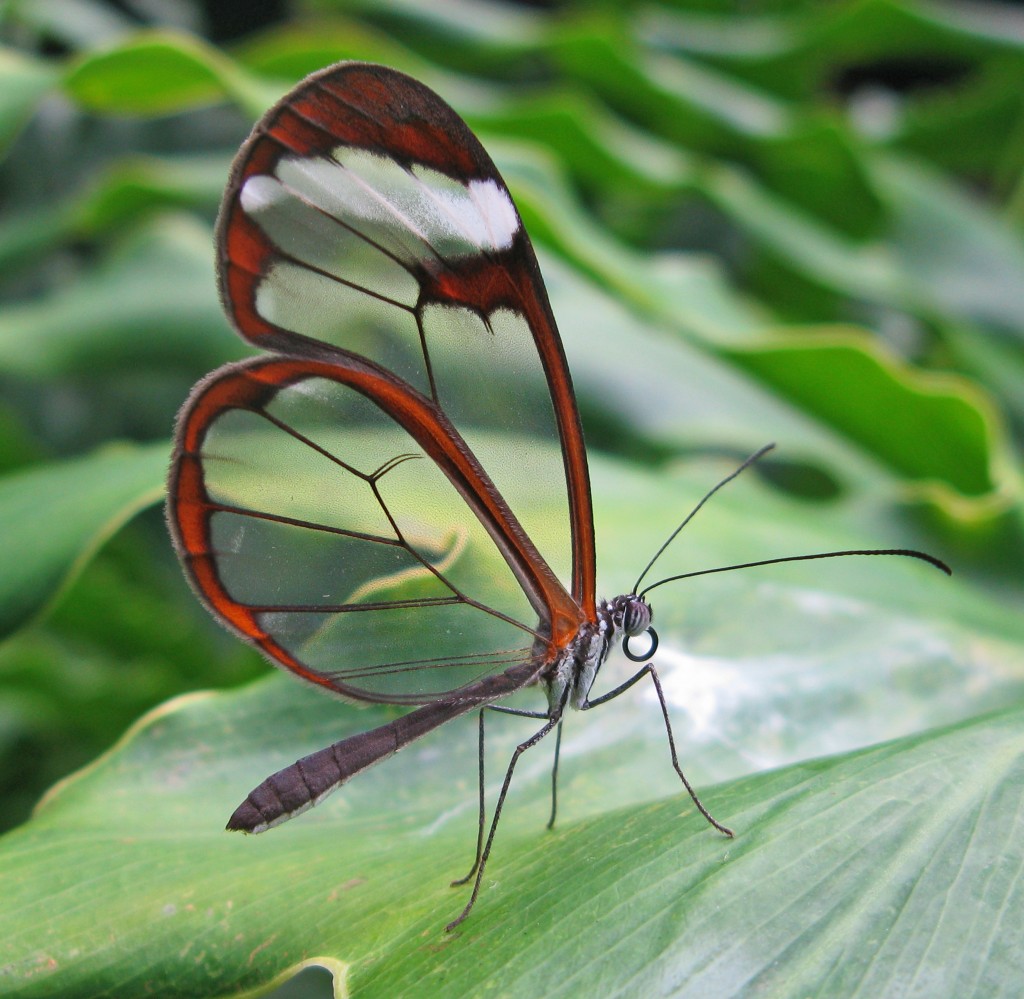
As with most butterflies it is a delicate looking species, but those who breed it in captivity have found it to be quite resilient and its wings are no less strong than those of other species. Another relief is the fact that in its native habitat it is quite common. Unless you live in South America, however, the only chance you will get of seeing the glasswing alive is in a butterfly house or farm.
If you want to see ‘little mirrors’ in the wild, however, you will have to take a trip – anywhere from Mexico to Panama in Central America will do the trick. You will also have to locate the nearest rainforest as the understory of this environment is where the glasswing prospers. They feed off the nectar of a variety of rainforest flowers but when it comes to laying their eggs and ensuring the survival of the next generation, the glasswing has a fine trick up its (metaphorical) sleeve.
The glasswing, where possible, will lay its eggs on a plant of the genus ‘Cestrum’. Its common name, to you and I, is the nightshade and it is highly poisonous. The caterpillars, which are striped in bright purple and red to warn possible predators, are thus a snack that birds and other animals will not enjoy at all. The alkaloids, a chemical in the plants that occurs naturally and is full of nitrogen, stay in the bodies of the glasswing in to adulthood meaning that even then they will not be an attractive meal.
During mating, the males will convert some of these alkaloids in to pheromones which will attract the females to them. The glasswing is also noted for its long migrations and the fact that the males of the species, when about to meet, practice lekking. This is when a host of males gather together to show off their best features en masse – the females then choosing the most dominant and visually exciting.
The glasswing, while not rare as a species, is one of very few land based animals that have successfully mastered the act of transparency. Now you see it, now you don’t.
Most butterflies sport colorful, eye-catching patterns on their wings. But some species, like the glasswing butterfly, use mostly transparent wings to hide in plain sight.

